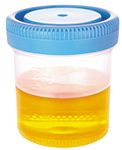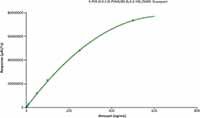Solid-Phase Extraction and LC–MS Analysis of Benzodiazepines in Urine
Benzodiazepines are extensively misused as a result of their hypnotic-sedative properties and relative availability, and they are often used in combination with other drugs, which can result in life-threatening conditions. This article presents a SPE and LC–MS method for the analysis of benzodiazepines in synthetic urine samples.
Benzodiazepines are extensively misused as a result of their hypnotic-sedative properties and relative availability, and they are often used in combination with other drugs, which can result in life-threatening conditions. There is a great need for forensic toxicologists to develop robust analytical methods to accurately and quickly measure benzodiazepines in biological fluids like urine in cases such as overdoses, sexual assaults, and fatalities.
Introduced in the 1960s to treat a series of medical maladies ranging from seizures, convulsions, and muscle spasms to anxiety disorders and acute alcoholism withdrawal, benzodiazepines' sedative properties and widespread availability make this group of drugs among the most popular controlled substances in the USA. Because they are so readily available by prescription, various forms of benzodiazepines (there are at least 17 prescribed varieties) have also become popular illegal street drugs with catchy names like "Zannies", "K-Cuts", and "Trangs". No matter what their name, benzodiazepines taken illegally pose a huge public health risk. Beyond a litany of physiological and psychological effects caused by the drugs, benzodiazepines are especially toxic when mixed with alcohol, opiates, and barbiturates because they interact with the same receptors in the body and dramatically increase the effect of the drugs. The results are often tragic, leading to a wide variety of conditions that range from seizures and respiratory distress to coma, cardiac arrest, and even death.1 Since there are generally three time-of-effect categories for benzodiazepines (ultra-short acting, short acting, and long acting), it is understood that the faster the reaction and effect of the drug on an individual's metabolism, the smaller the detection window. That poses an added challenge for clinical and forensic toxicologists to develop robust analytical methods to quickly measure benzodiazepines in biological fluids in such instances as sexual assaults, overdoses, and fatalities.2

(PHOTO CREDIT: DAWN POLAND/GETTY IMAGES)
While solid tissue samples are studied on occasion, for human studies the three most common matrices for drug testing are blood, urine, and saliva. Urine analysis is popular because, unlike blood, it requires no technical intervention to obtain samples. Samples tend to be collected in controlled environments, to prevent possible substitution of real samples by the donor. In addition, urine collected from healthy individuals is a sterile matrix, and so there are few concerns with exposing analysts to infectious agents.

Figure 1: Standard chromatogram of 100 ng/mL benzodiazepine mixture, inset table details the retention time and SIM for each of the benzodiazepines. * Diazepam (Peak 8) shows two signals, corresponding to the different Cl isotope contributions.
For the analyst, urine samples tend to be the cleanest biological matrix. Normal urine is approximately 95% water and so lacks a lot of the proteins and lipid-like compounds that challenge liquid chromatography coupled to mass spectrometry (LC–MS) analysis of blood samples. Urine does contain solutes such as urea, salts, creatinine, uric acid, enzymes, fatty acids, and hormones. Salt concentration tends to be high, so urine is often diluted by adding water prior to analysis to avoid blockages in the LC system or fouling of the mass spectrometer with most established methods for drugs in urine being "dilute-and-shoot" methods. However, more recently, as target levels for analysis have become more challenging, this very simple approach is inadequate and more sophisticated urine sample preparation methods are now more common. Dilute-and-shoot does not remove interfering matrix components that may suppress, or enhance the MS signal. Dilution of the sample also makes it more difficult to achieve the very low limits of quantitation required for many current drug tests. In addition, as the matrix profile varies from patient to patient, the resulting matrix effects can also vary, causing non-reproducible quantification.
Liquid–liquid extraction (LLE) can be used as a sample preparation technique in which an immiscible solvent is added to the sample. This separates into two liquid phases and the analyte of interest is extracted from one of the liquid partitions. It is inexpensive and method development time is quick. However, individual methods are long, potentially labour intensive, difficult to automate, can involve the use of large volumes of toxic organic chemicals and large quantities of glassware, and lack the selectivity of solid-phase extraction (SPE) methods. It can also be difficult to find a method which works for a range of analytes (and their metabolites) so more than one extraction may be required (more time).

Figure 2: Calibration curve for diazepam from 1â500 ng/mL. The assay showed excellent linearity with an r2 value of 0.999.
SPE has become a more popular method of sample preparation because it allows for robust reproducible methods and lends itself well to automation as a result of its availability in a 96-well format. SPE helps avoid potential errors in sample preparation, reducing re-runs and dramatically increasing productivity. As one of the most cost-effective and flexible tools within the laboratory environment, SPE also provides efficient sample concentration and purification prior to many of today's most popular analytical techniques, including high perfomance liquid chromatography (HPLC), LC–MS, gas chromatography (GC), and GC–MS. SPE columns are available in a wide variety of stationary phases, including reverse phase, normal phase, ion exchange, and mixed modes, allowing the analyst to fine-tune the selectivity of their extraction methods for a wide range of analytes.
This article presents a SPE and LC–MS method for the analysis of benzodiazepines in synthetic urine samples.
Experimental
Standards and Samples: The standards and samples were prepared as follows:
A certified eight component mix in acetonitrile (250 mg/mL per component) was used (Benzodiazepine mix [Cerilliant, B-033]) and contained the following compounds: alprazolam; clonazepam; diazepam; flunitrazepam; lorazepam; nitrazepam; oxazepam; and temazepam.
Working standards for instrument calibration were prepared in 20:80, acetonitrile:H2O solution over a range of 1–500 ng/mL.
Samples were prepared by spiking preserved synthetic urine (Surine, Cerilliant, 720-1) with the benzodiazepine mix at concentrations of 10 ng/mL (low spike) and 150 ng/mL (high spike) of each component.
UHPLC Method: The instruments used to conduct the analysis included a PerkinElmer Flexar FX-10 binary pump, Flexar FX-UHPLC autosampler, and Flexar Peltier column oven. The column used was a 100 mm × 2.1 mm, 2.7-µm SPP Phenyl-Hexyl (N9308485) (PerkinElmer). Mobile phase A: LC–MS-grade water with 0.1% formic acid and 0.5% acetonitrile. Mobile phase B: LC–MS-grade acetonitrile with 0.1% formic acid. Column temperature: 35 °C
MS Method: The spectrometer used in this analysis was a Flexar SQ300 single-quad mass spectrometer (PerkinElmer) set to the following specifications: Drying gas temperature: 325 °C; drying gas (N2) flow rate: 15 L/min; positive ESI mode with capillary exit voltage for all analytes was set at 100 V and dwell time for all ions was 25 ms; single ion monitoring (SIM) was used for all eight compounds.

Table 1: Gradient programme.
Calibration Results: The calibration standards used in this experiment were: 1, 5, 10, 50, 100, 250, and 500 ng/mL.
The limit of quantitation (LOQ), or concentration at which quantitative results can be reported with a high degree of confidence, was equal to or below 1 ng/mL
All benzodiazepines analyzed showed excellent curve fits with r2 values of 0.999, demonstrating that the assay was valid over the clinically relevant range.
SPE Method: Spiked Surine samples were prepared at concentrations of 10 ng/mL and 150 ng/mL. These levels were chosen to demonstrate precision and accuracy of the method at both low and high benzodiazepine concentrations. Extractions were conducted on Supra-Poly (PerkinElmer) 30 µm and 60 µm HLB 96-well plates, 30 mg × 2 mL (N9306698 & N9306695, respectively).
The extraction procedure for the benzodiazepines was as follows: The 96-well extraction plates were first conditioned with 1 × 1 mL methanol followed by 2 × 1 mL H2O. A 1 mL spiked sample of Surine was loaded onto the 96-well plates. The sample was then washed with 2 × 1 mL H2O, 1 × 1 mL 20% acetonitrile and dried for 5–10 min under vacuum. The sample was eluted from the 96-well plate with 1 mL of acetonitrile. The sample was dried under N2 at <40 °C and redissolved in 500 µL of 20% acetonitrile in H2O.
Extraction Results: Extraction results are provided for both 10 ng/mL spiked Surine and 150 ng/mL spiked surine samples (Table 2). Extractions were conducted on two solid-phase media "A" and "B", differing only in the particle sizes (30-µm and 60-µm particle diameter, respectively) to assess the two media types for recovery and reproducibility for the benzodiazepine mixture at a low and a high concentration spike.

Table 2: The extraction results for 10 ng/mL spiked Surine samples (low spike) and results for 150 ng/mL spiked Surine samples (high spike) extracted on both solid-phase media A and B.
Conclusion
Even with small detection windows, using SPE with LC–MS offers a highly reliable method to analyze benzodiazepines in urine with a recovery rate that exceeds 90%. It provides clean extracts and a single, simple protocol for a wide range of compounds. SPE also allows for robust and reproducible results even when the sample matrices vary from patient to patient. Finally, using the SPE process to test for benzodiazepines in urine can be automated, which speeds up procedures and helps laboratories to become more efficient and productive.
References
1. http://www.norchemlab.com/wp-content/uploads/2011/10/Benzodiazepines-facts.pdf
2. http://www.perkinelmer.com/CMSResources/Images/44-155955APP_011491_01_BenzodiazepinesinPlasma.pdf
Jason P. Weisenseel is currently the Chromatography Technical Leader for Aftermarkets with PerkinElmer, Environmental Health, Inc. (Shelton, Connecticut, USA), and a visiting research associate at Vanderbilt University (Nashville, Tennessee, USA). He was a tenured assistant professor of Chemistry at the University of North Alabama (Florence, Alabama, USA) prior to joining PerkinElmer, where he taught chemical instrumental analysis. Weisenseel earned a PhD in chemistry from Vanderbilt University in 2000.
E-mail: jason.weisenseel@perkinelmer.com
Website: www.perkinelmer.com

Investigating 3D-Printable Stationary Phases in Liquid Chromatography
May 7th 20253D printing technology has potential in chromatography, but a major challenge is developing materials with both high porosity and robust mechanical properties. Recently, scientists compared the separation performances of eight different 3D printable stationary phases.
Detecting Hyper-Fast Chromatographic Peaks Using Ion Mobility Spectrometry
May 6th 2025Ion mobility spectrometers can detect trace compounds quickly, though they can face various issues with detecting certain peaks. University of Hannover scientists created a new system for resolving hyper-fast gas chromatography (GC) peaks.
University of Oklahoma and UC Davis Researchers Probe Lipidomic Profiles with RP-LC–HRMS/MS
May 6th 2025A joint study between the University of Oklahoma Health Sciences Center (Oklahoma City, Oklahoma) and the UC Davis West Coast Metabolomics Center (Davis, California) identified differentially regulated lipids in type 2 diabetes (T2D) and obesity through the application of reversed-phase liquid chromatography-accurate mass tandem mass spectrometry (RP-LC-accurate MS/MS).

.png&w=3840&q=75)

.png&w=3840&q=75)



.png&w=3840&q=75)



.png&w=3840&q=75)








